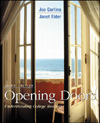 |  Opening Doors: Understanding College Reading, 3/e Joe Cortina,
Richland College
Janet Elder,
Richland College
What's New- Nine new reading selections with accompanying activities and exercises:
1-1 "Why Go to College?" (Nonfiction)
1-1 "Walter Anderson: Hero on Parade (Nonfiction)
2-1 "World Wide Web" (Information technology)
4-1 "The New Workforce" (Magazine Article)
4-2"Latinos" (Sociology)
5-3 "Demography" (Sociology)
6-1 "Benjamin Franklin" (Newspaper article)
7-1 "Career Choice" (Personal finance)
8-3 Excerpt from Joy Luck Club (Fiction)
9-1 "Sport Utility Vehicles: How Do I Hate Thee? Let Me Count the Ways" (Newspaper article)
9-3 "Take Out the Trash, and Put It…Where?" (Magazine article)
- Completely revised chapter on critical reading (Chapter 8)
- Author's purpose
- Author's intended audience
- Author's point of view (including a new discussion on author's bias)
- Author's tone and intended meaning (including expanded discussion of satire and irony and the definition
of words commonly used to describe tone)
- Completely new chapter on critical thinking (Chapter 9)
- Distinguishing facts from opinions (including an enhanced chart)
- Making inferences and drawing logical conclusions
- Evaluating an author's argument
- Identifying propaganda devices (including exercises)
- Distinguishing between inductive and deductive reasoning (with diagrams)
- Enhanced chapter on selecting and organizing textbook information (Chapter 10)
- Additional charts, graphs and diagrams (with exercises on interpreting these visual aids)
- Instructions and an example of a concept map (learning map) as alternative to outlining
- A brief introduction to the Cornell note-taking format
- Comprehension monitoring questions (for reading comprehension, critical reading and thinking, vocabulary, studying, and evaluating an author's argument) are now featured throughout the book in the margins and are summarized inside the front cover of the book.
- Dozens of new full-color photographs, cartoons, graphic materials, and other visual aids
- Use of color to designate important headings, subheadings, and key terms
- Informal learning-style inventory in Chapter 1
- Web links with each reading selection so that students can read more about the topic or the author of the selection
- New section on major versus minor supporting details (accompanied by diagrams) in Chapter 6
|
|



 2002 McGraw-Hill Higher Education
2002 McGraw-Hill Higher Education

 2002 McGraw-Hill Higher Education
2002 McGraw-Hill Higher Education